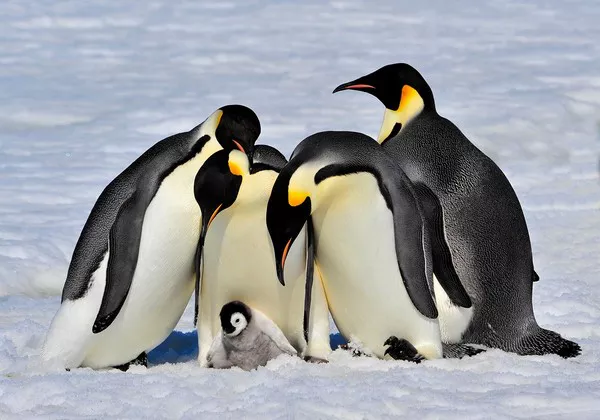Antarctica, a vast and icy wilderness at the southernmost tip of our planet, may seem inhospitable, but beneath its frozen exterior lies a vibrant ecosystem teeming with unique wildlife. In this exploration, we embark on a journey to discover the top ten animals that call Antarctica home. From colossal marine mammals to resilient seabirds, these creatures have adapted to the extreme conditions of the southern frozen continent, showcasing the remarkable diversity of life in one of the most challenging environments on Earth.
Top 10 Animals You Can See In Antarctica
1. Emperor Penguin (Aptenodytes forsteri)
The emperor penguin, with its iconic tuxedo-like plumage, is the largest and most iconic penguin species. These remarkable birds are masters of endurance, enduring the harsh Antarctic winters by huddling together in large colonies to conserve warmth. Known for their epic long-distance journeys to find food, emperor penguins are a symbol of resilience in the face of extreme conditions.
2. Weddell Seal (Leptonychotes weddellii)
The Weddell seal, a robust marine mammal, has adapted to both the icy Antarctic waters and the frigid temperatures on land. Known for its exceptional diving abilities, the Weddell seal can plunge to depths of over 2,000 feet in search of prey. With a population estimated at around 800,000 individuals, these seals have successfully carved out a niche in Antarctica’s challenging environment.
3. Adélie Penguin (Pygoscelis adeliae)
The Adélie penguin, characterized by its distinct black head and white eye ring, is a highly social and acrobatic bird species. Thriving in the harsh Antarctic conditions, Adélie penguins are adept swimmers and agile on land. With an estimated population of 2.5 million breeding pairs, they represent one of the most numerous seabirds in the Antarctic ecosystem.
4. Leopard Seal (Hydrurga leptonyx)
The leopard seal, a formidable apex predator, reigns supreme in the waters surrounding Antarctica. Recognized for its sleek, spotted coat, this marine mammal is known for its powerful swimming abilities and carnivorous diet. Leopard seals play a crucial role in maintaining the balance of the Southern Ocean’s food web, preying on penguins and smaller seals.
5. Antarctic Minke Whale (Balaenoptera bonaerensis)
The Antarctic minke whale, a baleen whale species, graces the icy waters of Antarctica with its presence. Despite being one of the smallest baleen whales, Antarctic minkes are known for their elusive nature, often avoiding boats and human encounters. With an estimated population ranging from hundreds of thousands to over a million individuals, these majestic creatures are integral to the Antarctic marine ecosystem.
6. Snow Petrel (Pagodroma nivea)
The snow petrel, an ethereal seabird, is perfectly adapted to the extreme Antarctic environment. With its pure white plumage and black eyes, the snow petrel is an iconic Antarctic species. These avian navigators cover vast distances in search of food, relying on their keen sense of direction to navigate the expansive icy landscapes.
7. Orca (Orcinus orca)
Orcas, or killer whales, are formidable apex predators found in the Southern Ocean surrounding Antarctica. Known for their intelligence and complex social structures, these marine mammals play a crucial role in the Antarctic ecosystem by regulating populations of prey species. Orcas are highly adaptable, with distinct populations exhibiting specialized feeding behaviors, including the famous “wave-washing” technique used to knock seals off ice floes.
8. Chinstrap Penguin (Pygoscelis antarcticus)
The chinstrap penguin, easily recognizable by its distinctive black cap and thin line of black feathers under its chin, is a crested seabird thriving in the Antarctic Peninsula. With an estimated global population exceeding eight million pairs, these agile and social penguins have successfully adapted to the challenges of their frozen habitat.
9. Blue Whale (Balaenoptera musculus)
The blue whale, the largest animal on Earth, graces the Southern Ocean surrounding Antarctica. With a maximum length of around 100 feet and weighing as much as 200 tons, these colossal marine mammals are a testament to the incredible biodiversity of the Antarctic ecosystem. Blue whales are filter feeders, consuming vast amounts of krill, and their populations are slowly recovering following decades of whaling.
10. South Polar Skua (Stercorarius maccormicki)
The South Polar skua, a predatory seabird, has adapted to life in the harsh Antarctic environment as a skilled scavenger. Thriving on a diet of carrion and stealing food from other birds, these opportunistic skua species contribute to the nutrient cycling in the region. With their impressive flying capabilities, South Polar skuas navigate vast distances across the Southern Ocean.
See Also: Top 10 Animals With The Best Hearing
Conclusion:
Antarctica, often considered a pristine and untouched wilderness, is home to a remarkable array of wildlife uniquely adapted to its extreme conditions. From the iconic emperor penguin to the colossal blue whale, each species plays a crucial role in maintaining the delicate balance of the Antarctic ecosystem. As we continue to unravel the mysteries of this frozen continent, a deeper understanding of its biodiversity becomes essential for conservation efforts and the preservation of one of Earth’s last true wildernesses.
You Might Be Interested In:



























